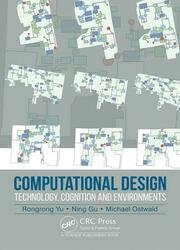 Название
Название: Computational Design: Technology, Cognition and Environments
Автор: Rongrong Yu, Ning Gu, Michael J. Ostwald
Издательство: CRC Press
Год: 2021
Страниц: 253
Язык: английский
Формат: pdf (true)
Размер: 10.1 MB
An essential guide for teaching and learning computational art and design: exercises, assignments, interviews, and more than 170 illustrations of creative work.
There are two common ways of understanding the field of ‘computational design’. First, it can be defined as a systematic way of thinking about or conceptualising the design process. This could be understood as a rigorous reasoning method founded in the timeless fields of mathematics and logic. The second definition of computational design encapsulates the hardware, software and systems that support the act of designing. These have developed rapidly over time to respond to the needs of designers. The scope of this book encompasses both of these definitions of computational design, as well as the overlap or interdependency between them. This is a particularly interesting way of approaching the topic of computational design, because it emphasises the interactions between a seemingly stable body of knowledge on the one hand, and an increasingly dynamic technological environment on the other.
Three distinct aspects of computational design are introduced and explored in this book: design technology, design thinking and design environments. The first is associated with the hardware, software and systems used to support design, and which might in turn shape the way designers work and think. The second is concerned with the cognitive mental processes that occur during acts of designing, and which are influenced by computational design technologies. The third explores a variety of coexisting computational environments and contexts that are available to designers. This book does not, however, completely separate these three. Instead, it examines the connections between them, gradually building up a picture - literally a multi-stage figure and conceptual model – which explains how they shape one another.
Contents:
Acknowledgements
Preface
1. Introduction
1.1. Computational design
1.2. Design technology, cognition and design environment
1.3. Summary of chapters
1.4. Context for the book
2. Emergent Technologies in Computational Design
2.1. Introduction
2.1.1. History of CAD
2.1.2. Evolution of digital modelling devices
2.1.3. Evolution of CAD software and hardware
2.2. Parametric and generative design
2.2.1. Key concepts and characteristics of generative design
2.2.2. Major generative design systems
2.2.3. Key concepts in parametric design
2.2.4. History and application of parametric design
2.3. Presence and telepresence, virtual and real worlds
2.3.1. Telepresence
2.3.2. Augmented Reality
2.3.3. Virtual Reality
3. Understanding Design Cognition in Computational and Generative Design
3.1. Design cognition
3.1.1. Design thinking
3.1.2. Design problems and design solutions
3.1.3. Design creativity
3.2. Formal approaches to studying design cognition
3.3. Design cognition in the computational design environment
4. Cognitive Impacts and Computational Design Environments
4.1. Introduction
4.2. Case study 1: Designers’ behaviour in parametric and geometric design environments
4.3. Case study 2: Cognitive studies of design collaboration in a virtual environment
4.4. Case study 3: A biometric approach to analysing cognitive behaviour in a CAD environment
4.5. Case study 4: Implementing rules in design, using generative design grammars
4.6. Case study 5.1: Generating new design instances of an existing style using computational analysis
5. Conclusion
Appendix: Coding Example for Case Study 1
Appendix of Images Sources
Index
Скачать Computational Design: Technology, Cognition and Environments
[related-news]
[/related-news]